In India’s most populous (166 million) and socio-economically backward heartland state, institutions of education are perpetually under siege. Yet despite routine lawlessness and rise of politically protected crime syndicates, a small minority of higher education institutions have been able to maintain high academic and research standards. Puja Awasthi reports
February 2006. Farah Aziz Khanum, a journalism student at Aligarh Muslim University, is molested by a group of students of the varsity. When she complains to the students’ union, she is told she deserved it for wearing jeans and t-shirt on campus.
June 2008. Allahabad University files criminal cases against four student leaders for assaulting a professor. The student leaders alleged that the professor had favoured his relatives in the university’s examination and also opposed student union elections.
October 2009. A raid on a printing press yields 4,000 forged marksheets bearing the B.R. Ambedkar University, Agra hologram. The FIR registered with the police cites an unnamed university employee who had placed the order for Rs.50,000. A month later, question papers of the B.Tech exam are leaked, forcing the university to cancel it.
November 2009. Nine students of the Benares Hindu University are expelled for indulging in hooliganism after getting drunk on campus.
.gif) In India’s most populous Hindi heartland of Uttar Pradesh (pop.166 million), arguably the country’s most lawless and socio-economically backward state (adult literacy: 56.27 percent; per capita income: Rs.5,877 per annum), institutions of education — particularly higher education — are under perpetual siege even as they are crippled by systemic failure, teacher shortages, student violence, outdated curricula, poor infrastructure and excessive political interference. Despite Uttar Pradesh being 1.16 times the size of Britain and boasting three times its population, the state hosts a mere 24 public universities, eight deemed (private) universities, one institute of national importance and only ten research institutes. Moreover a mere 1.76 million youth (12.57 percent of the age group 18-24) are enroled in tertiary education institutions which include 1,637 colleges of general education, 114 engineering, technical and architecture colleges and 93 medical colleges, and only 1.48 percent of the state’s gross domestic product is spent on higher education.
In India’s most populous Hindi heartland of Uttar Pradesh (pop.166 million), arguably the country’s most lawless and socio-economically backward state (adult literacy: 56.27 percent; per capita income: Rs.5,877 per annum), institutions of education — particularly higher education — are under perpetual siege even as they are crippled by systemic failure, teacher shortages, student violence, outdated curricula, poor infrastructure and excessive political interference. Despite Uttar Pradesh being 1.16 times the size of Britain and boasting three times its population, the state hosts a mere 24 public universities, eight deemed (private) universities, one institute of national importance and only ten research institutes. Moreover a mere 1.76 million youth (12.57 percent of the age group 18-24) are enroled in tertiary education institutions which include 1,637 colleges of general education, 114 engineering, technical and architecture colleges and 93 medical colleges, and only 1.48 percent of the state’s gross domestic product is spent on higher education.
With their feeder institutions — UP’s 135,484 government-run primary and secondary schools — alumni of the state’s 44,485 private schools tend to bypass its higher education system and head for other states — in a shambles characterised by crumbling infrastr-ucture, single teacher schools (5.2 percent) and a high primary-secondary drop out percentage (41.25), it’s hardly surprising that the state’s institutions of higher education are in equal disrepair. The overwhelming majority of students entering institutions of higher education are under-prepared, a situation not helped by administrative incompetence and laxity in Lucknow (pop. 2.2 million), the state capital from where the government dominated higher education system is (mal) administered.
 Comments Ram Prakash Singh, former vice chancellor of Lucknow University (2005-08), who faced stiff student resistance for attempting to reform this vintage university (estb.1921): “The persistent neglect of higher education in Uttar Pradesh by the state and Central governments has vitiated the environment. Various types of mafia — caste, criminal and political — vested interests, employees, students and teachers unions have created anarchy in UP’s universities. Due to these factors university administrations have become weak and self-serving, with inadequate state funding worsening the situation.”
Comments Ram Prakash Singh, former vice chancellor of Lucknow University (2005-08), who faced stiff student resistance for attempting to reform this vintage university (estb.1921): “The persistent neglect of higher education in Uttar Pradesh by the state and Central governments has vitiated the environment. Various types of mafia — caste, criminal and political — vested interests, employees, students and teachers unions have created anarchy in UP’s universities. Due to these factors university administrations have become weak and self-serving, with inadequate state funding worsening the situation.”
Umesh Tripathi, a former district inspector of schools whose crackdown on cheating has made him a target of the state’s powerful mafia which sells exam papers to highest bidders, blames lawlessness and the low-priority given by the state government to education for UP’s declining education standards. “Anti-social elements have transformed the ideals of education from mental, emotional, intellectual, spiritual and physical development to just passing exams any which way. They have one guiding principle: give us money, we will give you results. And this starts from the filling of examination forms and goes upto the evaluation stage. A vicious cycle has been created by an education mafia which has defeated the purpose of education. Today we can neither judge the validity of our curriculums nor the quality of the students who are coming out of the system,” says Tripathi with more than a trace of bitterness.
Yet despite the routine lawlessness and rise of politically protected crime syndicates, which have spread their tentacles into the education system and institutions of India’s most populous state which contributes 85 (of 543) members to the Lok Sabha in Delhi, a small minority of higher education institutions has been able to maintain high academic and research standards, and perhaps even excel. Due to a combination of factors — including determined leadership — contemporary Uttar Pradesh hosts several islands of academic excellence. Some of them are profiled below.
Indian Institute of Management, Lucknow
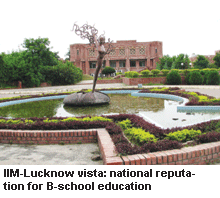 Spread over 185 acres in the suburbs of the unruly state capital, the Indian Institute of Management, Lucknow (IIM-L, estb. 1984) has established a national reputation for dispensing high quality business management education. In a national opinion poll conducted by the Marketing and Development Research Associates (MDRA) for the Delhi-based newsweekly Outlook (September 28, 2009), IIM-L was ranked fifth among India’s top 75 B-schools.
Spread over 185 acres in the suburbs of the unruly state capital, the Indian Institute of Management, Lucknow (IIM-L, estb. 1984) has established a national reputation for dispensing high quality business management education. In a national opinion poll conducted by the Marketing and Development Research Associates (MDRA) for the Delhi-based newsweekly Outlook (September 28, 2009), IIM-L was ranked fifth among India’s top 75 B-schools.
Another recent survey of the country’s top B-schools conducted by the Gurgaon-based Centre for Forecas-ting and Research (C fore) for the New Delhi-based weekly Open, ranks IIM-L fourth among India’s 50 best business management education institutions.
Even the recessionary winds blowing over the global economy haven’t taken much sheen off IIM-L. While in 2008, the average start-up remuneration package offered to graduates was Rs.4.2 lakh, in 2009 it dipped slightly to Rs.3.5 lakh. And this year’s summer placements witnessed a 25 percent increase in terms of job offers to students. Moreover not only has the UP state government respected the autonomy of IIM-L, it has developed a close — and by all indicators proud — relationship with the institute. It has commissioned IIM-L to conduct research and provide consultancy advice in several areas including rural development and health management, and in overhauling the state’s moribund passport office.
On the contrary, IIM-L’s major problem has been created by the Central government in distant New Delhi and is the legacy of former Union HRD minister Arjun Singh, who in 2006 unilaterally decreed an additional 27 percent reservation quota for OBC (other backward castes/classes), i.e in addition to 22.5 percent for scheduled caste and scheduled tribe students, in all Central government promoted and funded institutions of higher education, including the country’s seven IIMs.
As IIM managements prepare to increase their annual intake of students by 27 percent under a compromise formula, IIM-L’s director Dr. Devi Singh’s concern is how students admitted under preferential reserved quotas will perform within the highly competitive IIM-L environment. “They might not do well in IIM if they don’t have the right kind of experience and potential. My fear is that even after admitting SC, ST and OBC students with 10 percent lower averages in CAT, we may not be able to fill the OBC quota,” he says.
Jaipuria Institute of Management, Lucknow
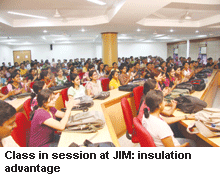 Although not quite in the same league as IIM-L, the Jaipuria Institute of Management (JIM), Lucknow’s premier private sector B-school promoted by the city’s prominent Jaipuria family (Ginni International) in 1995, has established a reputation as an island of academic excellence in Uttar Pradesh. Ranked 54th among the country’s 1,000 plus B-schools in the Outlook-MRDA 2009 survey of management institutes and 22nd in the Open-C fore poll, the JIM management has been able to insulate the institute from UP politics and the state’s notorious crime syndicates.
Although not quite in the same league as IIM-L, the Jaipuria Institute of Management (JIM), Lucknow’s premier private sector B-school promoted by the city’s prominent Jaipuria family (Ginni International) in 1995, has established a reputation as an island of academic excellence in Uttar Pradesh. Ranked 54th among the country’s 1,000 plus B-schools in the Outlook-MRDA 2009 survey of management institutes and 22nd in the Open-C fore poll, the JIM management has been able to insulate the institute from UP politics and the state’s notorious crime syndicates.
“Luckily for us, the larger socio-economic problems of UP haven’t entered our campus,” says JIM director Subrata Chakraborty, a former dean of IIM-L who came aboard JIM in 2004. “We have clear cut admission criteria. There have been cases where some pressures have been applied to admit undeserving students, but we have been firm in our refusal. Fortunately I have the complete support of our chairman who does not interfere in the college’s day to day affairs,” says Chakraborty.
Similarly the violently agitational student politics peculiar to UP have been kept out of the campus by constituting a Students’ Council which besides helping students individually, also has a say in decisions relating to student welfare.
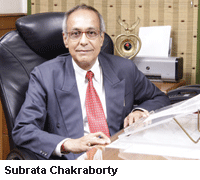 Consequently despite being a B-school of recent vintage sited in an academically backward state, JIM has attained sufficient reputation to ink an agreement with the University of Illinois (2009). This partnership enables JIM to send six students to the university for a one semester study term on scholarships. A similar student exchange programme was also signed with Thailand’s Naresuan University in November 2007.
Consequently despite being a B-school of recent vintage sited in an academically backward state, JIM has attained sufficient reputation to ink an agreement with the University of Illinois (2009). This partnership enables JIM to send six students to the university for a one semester study term on scholarships. A similar student exchange programme was also signed with Thailand’s Naresuan University in November 2007.
The sound reputation the JIM management has established is reflected in the institute’s graduate placement record. Earlier this year, 24 companies visited the campus for recruiting the batch of 2009. All 120 MBA students were placed with start-up remuneration packages averaging Rs.3.8 lakh against the 2008 average of Rs.4.40 lakh, a “slightly lower” compensation attrib-uted to recessionary conditions.
Benares Hindu University
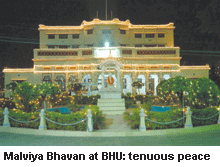 It is paradoxical, but typical of Nehruvian socialist India that the most socio-economically backward of the 29 states of the Indian Union, also hosts one of the country’s most research-driven universities. Established in 1916, the Benares Hindu University (BHU) is one of the country’s largest Central government-funded universities with an aggregate enrolment of 16,831 students and 1,800 faculty. According to a Union ministry of human resource development report (2007-08), BHU comprises three institutes, 15 faculties, 130 departments, four inter-disciplinary schools, one constituent college, four affiliated colleges and three schools which together offer 62 undergraduate, 152 postgraduate, 55 diploma and 14 certificate courses.
It is paradoxical, but typical of Nehruvian socialist India that the most socio-economically backward of the 29 states of the Indian Union, also hosts one of the country’s most research-driven universities. Established in 1916, the Benares Hindu University (BHU) is one of the country’s largest Central government-funded universities with an aggregate enrolment of 16,831 students and 1,800 faculty. According to a Union ministry of human resource development report (2007-08), BHU comprises three institutes, 15 faculties, 130 departments, four inter-disciplinary schools, one constituent college, four affiliated colleges and three schools which together offer 62 undergraduate, 152 postgraduate, 55 diploma and 14 certificate courses.
The unlikely research orientation of BHU is testified by the Bangalore-based journal Current Science (September 25, 2009) which ranks the university first countrywide for the largest number of research papers published by its faculty. Likewise the Delhi-based National Institute of Science Communication and Inform-ation Resources ranks BHU second (behind Delhi University) in the list of the top 20 research-oriented universities of India. Moreover the National Assessment and Accreditation Council (NACC) has assessed BHU as a top ‘A’ category institution of higher learning.
But although the university’s vice chancellor, Dr. Dhirendra Pal Singh believes that distance from Delhi and its Central university status has devolved considerable autonomy from governments at the Centre and in Lucknow, UP’s aggressive and violent student politics has breached the campus walls of BHU. In February 1997 during student union elections, the varsity’s campus was turned upside down following large scale violence between opposing student groups. In 1997 student unions were dissolved and union activity was prohibited by BHU. However in 2007, the then vice chancellor Panjab Singh permitted the establishment of a Students’ Council of which the vice chancellor is chairman while a senior professor serves as vice-chairman. Student representatives of various institutes and faculties are members of the council and they elect the secretary.
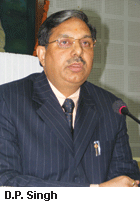 With a tenuous peace being restored on this university’s sprawling 1,300 acre main campus (as also on BHU’s 2,760 acre south campus in the forest area of Barkachha in Mirzapur district), BHU and its constituent colleges are highly ranked in the annual surveys of the country’s most respected institutions of higher education. The India Today 2009 survey of India’s top colleges ranked the Institute of Technology-BHU eighth, its faculty of law 11th and its B-school 15th. Official acknowledgement of BHU’s consistent efforts to maintain academic and research standards in critical domains of knowledge has also been generous. The Delhi-based Univ-ersity Grants Commission has allocated BHU a development grant of Rs.283.76 crore in addition to an OBC (other backward caste) grant of Rs.561.25 crore.
With a tenuous peace being restored on this university’s sprawling 1,300 acre main campus (as also on BHU’s 2,760 acre south campus in the forest area of Barkachha in Mirzapur district), BHU and its constituent colleges are highly ranked in the annual surveys of the country’s most respected institutions of higher education. The India Today 2009 survey of India’s top colleges ranked the Institute of Technology-BHU eighth, its faculty of law 11th and its B-school 15th. Official acknowledgement of BHU’s consistent efforts to maintain academic and research standards in critical domains of knowledge has also been generous. The Delhi-based Univ-ersity Grants Commission has allocated BHU a development grant of Rs.283.76 crore in addition to an OBC (other backward caste) grant of Rs.561.25 crore.
“During the past decade in particular, the management and faculty of BHU has made a determined effort to improve teaching-learning standards and have constituted a high-level task force for fostering research excellence. Moreover we have also identified some focus areas in which by 2016 — our centenary year — we hope to establish BHU as a global research leader. To this end we intend promoting an Institute of Envi-ronment and Sustainable Development and a Unesco Peace Centre to intensively research global warming and climate change issues, and undertake inter-faith studies to mitigate religious conflict around the world,” says vice chancellor Dr. Dhirendra Pal Singh.
Aligarh Muslim University
.gif) Established in 1875 prior to the promotion of the Benaras Hindu University in Varanasi — in the subtle divide et impera (divide and rule) style of the British raj — Aligarh Muslim University, which encompasses 467 acres in the epony-mous city (pop. 6.67 lakh), has experienced greater student agitation and law and order problems than BHU in recent times. During the past two years, four students have been murdered on campus.
Established in 1875 prior to the promotion of the Benaras Hindu University in Varanasi — in the subtle divide et impera (divide and rule) style of the British raj — Aligarh Muslim University, which encompasses 467 acres in the epony-mous city (pop. 6.67 lakh), has experienced greater student agitation and law and order problems than BHU in recent times. During the past two years, four students have been murdered on campus.
Moreover the vice chancellor P.K. Abdul Azis, appointed in 2007, is having a hard time maintaining his authority over the varsity (his academic credentials are being questioned; senior Ph D students are protesting a decision to reduce their intake and not accept theses submitted after five years of registration; teachers have expressed resentment against removal of their additional administrative responsi-bilities, and charges of financial irregularities have also been made).
Nevertheless AMU with its 88 departments, five institutions, 13 centres, 28,000 students, mostly resident in 16 halls of residence with 70 hostels, is a highly reputed institution of higher education. Ranked 18th by the National Institute of Science Communication and Information Resources for 387 research papers published in 2008, the university awarded 391 Ph Ds in 2008-09. AMU has also inked collaboration agreements with foreign universities in the US, Iran, Australia and Muscat and is served by an influential Alumni Foundation which will contribute Rs.100 crore to augment the Central government grant of Rs.185 crore for capital investment during the XIth Plan period (2007-12). Five special centres of AMU are also proposed for Bihar, Madhya Pradesh, West Bengal, Maharashtra and Kerala at an estimated cost of Rs.2,000 crore.
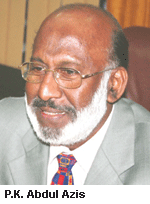 An acknowledged national centre of academic excellence, apart from 110 study programmes, the university also offers specialist courses such as Islamic banking and finance. In 2009, 45 of its alumni were admitted into IITs and four were awarded Fullbright Scholarships to study in the US. Moreover under the Central government’s Innovation in Science Pursuit for Inspired Research (INSPIRE) Programme (launched in November 2008 and run by the Department of Science and Techno-logy), the university has been chosen for special funding. And to increase and facilitate entry of minority community candidates into the civil services, the university has been recently granted Rs.13 crore by the Central government to run a fully residential Civil Services Coaching Academy.
An acknowledged national centre of academic excellence, apart from 110 study programmes, the university also offers specialist courses such as Islamic banking and finance. In 2009, 45 of its alumni were admitted into IITs and four were awarded Fullbright Scholarships to study in the US. Moreover under the Central government’s Innovation in Science Pursuit for Inspired Research (INSPIRE) Programme (launched in November 2008 and run by the Department of Science and Techno-logy), the university has been chosen for special funding. And to increase and facilitate entry of minority community candidates into the civil services, the university has been recently granted Rs.13 crore by the Central government to run a fully residential Civil Services Coaching Academy.
In October, since the brutal murder on campus of Shahnawaz Alam, a final year B.Sc student, the vice chancellor Dr. P.K. Abdul Azis has proscribed media interviews and was unavailable for comment.
Institute of Hotel Management, Lucknow
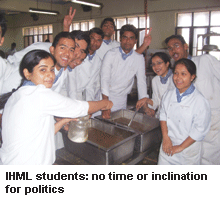 Promoted by the Central government in 1969 as the Food Craft Institute, the Institute of Hotel Management, Lucknow (IHML) was upgraded to its present status under the aegis of the Union ministry of tourism in 1980. Currently IHML, which occupies a four-acre campus in Aliganj, Lucknow, offers a three-year B.Sc hospitality and hotel adminis-tration programme to 158 students instructed by 13 permanent faculty.
Promoted by the Central government in 1969 as the Food Craft Institute, the Institute of Hotel Management, Lucknow (IHML) was upgraded to its present status under the aegis of the Union ministry of tourism in 1980. Currently IHML, which occupies a four-acre campus in Aliganj, Lucknow, offers a three-year B.Sc hospitality and hotel adminis-tration programme to 158 students instructed by 13 permanent faculty.
One of 22 Central government prom-oted institutions of hotel management, over the past 28 years successive administrations of the institute have done a commendable job of insulating the institute from the state’s turbulent adult and student politics beyond campus gates. “Since we are a Central government institution reporting to the Union tourism ministry, we don’t have much interaction with state government departments. Besides we have a cosmopolitan mix of students intent on acquiring professional certification to work in the fast-developing hotels and hospitality industries. Therefore our students have very little time or inclination for student politics,” says Arun Kumar Singh, principal of IHML.
The IHML campus bristles with IT-enabled audio visual aids while the Indira Gandhi National Open University is connected to it through V-sat (very small aperture terminal) linkages, and the faculty is routinely sent on exchange programmes to the world’s best hotels.
 “We make changes to our curriculum every year to keep both the faculty and students in step with global hospitality industry trends. Moreover this year we’ve switched to the semester testing system to ensure that our students are learning continuously,” says Singh.
“We make changes to our curriculum every year to keep both the faculty and students in step with global hospitality industry trends. Moreover this year we’ve switched to the semester testing system to ensure that our students are learning continuously,” says Singh.
Institutional and curriculum innova-tions over a quarter century have paid off in terms of campus recruitments and institutional placements. In 2007-08, 22 companies came recruiting with 281 job offers from top recruiters such as The Oberoi, Taj Hotels and Resorts and Pizza Hut. The average monthly start-up pay was Rs.11,500. In 2008-09, the number of job offers was 277 with the average start-up pay rising to Rs.12,500.
Indian Institute of Technology, Kanpur
.gif) Now in its golden jubilee year, Indian Institute of Technology, Kanpur (IIT-K, estb.1959) has acquired a global reputation as one of Asia’s most respected engineering colleges. Spread over 4.3 sq. km in the north-west of the city of Kanpur (pop.4.8 million), currently IIT-K has an aggregate 3,731 students enroled in its undergraduate and postgrad study programmes covering the engineering, science, humanities and business management disciplines.
Now in its golden jubilee year, Indian Institute of Technology, Kanpur (IIT-K, estb.1959) has acquired a global reputation as one of Asia’s most respected engineering colleges. Spread over 4.3 sq. km in the north-west of the city of Kanpur (pop.4.8 million), currently IIT-K has an aggregate 3,731 students enroled in its undergraduate and postgrad study programmes covering the engineering, science, humanities and business management disciplines.
Equipped with its fully-wired P.K. Kelkar library with a collection of over 300,000 volumes and 1,000 journal subscriptions, IIT-K offers world class teaching and research facilities. Accor-ding to Current Science (August 2009), the 6,234 research papers published by IIT-K in 2008 with 19,432 citations in reputable journals, is second only to the Indian Institute of Science, Bangalore.
Moreover in the current year, faculty of the institute have bagged national honours. Among them: Prof. Manindra Aggarwal of the department of computer science and engineering was awarded the 19th G.D. Birla Award for scientific research; Dr. Kantesh Balani of the department of materials and metallur-gical engineering has been short-listed for the Young Scientists Award and Dr. Sudeep Bhattacharjee of the department of physics is scheduled to receive the 2010 Endeavour Research Award while Dr. Anish Upadhyaya of the department of materials and metallurgical engineer-ing has been selected Metallurgist of the Year 2009. Moreover Dr. R. Balasubramaniam, head of the depart-ment of materials and metallurgical engineering, has been selected to receive the inaugural IIM Distinguished Educator Award 2009.
The emergence and survival of these and other (including K-12) institutions of academic excellence in Uttar Pradesh suggests that it is possible for determined education leaders and visionaries to resist and withstand political, caste, crime syndicates and teacher and student union pressures for which this heartland state has acquired notoriety.
The Right to Free & Compul-sory Education Bill 2009 (awaiting presidential assent), which makes it mandatory for the State (Central and state governments) to provide elementary education to all children in the six-14 age group, offers a chance to make a new beginning in the vital K-12 education sector. With local SMDCs (School Monitoring and Development Committees) empowered to supervise local schools and teachers, there’s a new opportunity to raise standards in school education which are the supply chain of institutions of higher education.
Meanwhile at the state government level in Lucknow, a high-powered committee has been constituted to make recommen-dations for upgrading UP’s beleaguered colleges and universities. Though the committee constituted in June 2009 was obliged to summit its report in October 2009, it hasn’t met the deadline.
Headed by Prof. Hari Gautam, former chairman of the University Grants Commission, the committee has been given the brief to draft a higher education policy for the state and recommend ways and means to precipitate qualitative improvement with social equity in the higher education sector. Other members of the committee include the director of IIT-Kanpur, vice chancellor of the Rohilkhand University (Bareilly), RML National Law University (Lucknow), Gautam Buddh University (Noida) and Faizabad University.
According to reliable academic sources in Lucknow, the Gautam committee has studied various proposals of the government of India and has thoroughly examined best practices followed in other states. The committee will focus on measures to tighten admission regulations, tuition fee norms, affiliation regimes in colleges and state universities. A policy docu-ment setting a goal for comprehensive restructuring of the state’s 24 universities and 1,637 colleges by the year 2020 is likely to emerge from the committee’s deliberations.
In the critically important state of Uttar Pradesh which hosts 16 percent of India’s population, education institu-tions, especially of higher education are besieged by political, caste, crime and examination mafias. Yet as the example of UP’s islands of excellence demonstrate, all is not lost.
With Sushant Parmar (Varanasi)